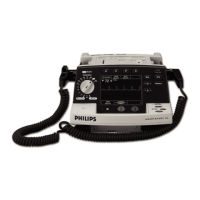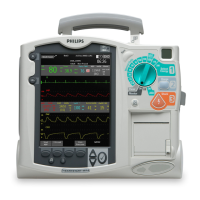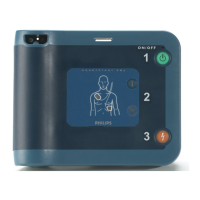Opening the Case
4-30 Removal and Replacement
Discharge the Defibrillator Capacitor
The steps that follow describe how to discharging the unit’s Defibrillator
Capacitor.
WAR NI NG Always discharge the defibrillator capacitor before servicing this unit.
WAR NI NG To avoid completing a high voltage circuit, use only one hand to perform the
following steps. Keep the other hand away from the unit at all times. Touch only
the parts described.
1. Lift the capacitor out of the way.
Lift up the defibrillator capacitor together with its foam base. Lift straight
up, then turn the capacitor to the right and rest it on the Power PCA. See
Figure 4-18.
2. Inspect the Disarm Pathway.
Look for signs of arcing, burning, damage to the resistors or inductor,
blown traces on the Power PCA, etc.
TIP: The Disarm Pathway is located under the Defibrillator Capacitor on
the left side of the Power PCA. The Disarm Pathway consists of two
large power resistors (Disarm Resistors), a red inductor, and the PCA
traces that connect them. See Figure 4-18.
3. Choose a discharge method.
z If the Disarm Pathway is intact, refer to See Figure 4-18 on page 4-
31. and use the Primary Method below to discharge the defibrillator
capacitor.
z If you see any burns or damage, the Disarm Pathway may not be
intact. Use the Primary Method, then also
use the Secondary
Method to discharge the defibrillator capacitor.
Primary Method
a. Using the High Voltage Discharge Tool, first touch one end of the
tool’s brass bar to the current sensing resistor (the small loop of flat
metal). See See Figure 4-18 on page 4-31.
b. Then pivot the brass bar so its other end contacts the exposed end of
the disarm resistor.
c. Maintain contact at these two points for at least 5 seconds. The
defibrillator capacitor is now discharged.

